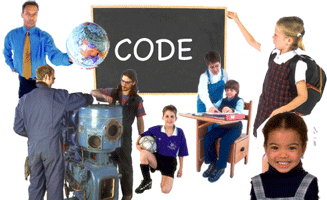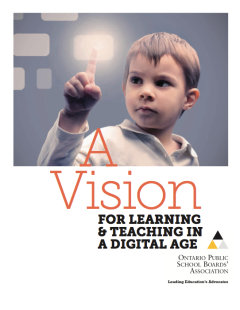Oct
2017
My Vision for Technology Use in Education
I am six days into my Integrating Information and Computer Technology Part 3 AQ, and have been asked to write a blog post about my vision for technology use in education and how said vision compares and contrasts with some of the resources we’ve reviewed so far. In the organizational sense, Visions tend to be only marginally longer than Mission Statements. But how do I turn my thoughts on technology use in education into an elevator pitch when I am still mentally sorting through so many thoughts, ideas and action plans suggested my colleagues, my board, the Ontario Ministry of Education, the twittersphere…? Hmm.
 My vision for technology use in education does not include specific apps or devices or platforms. It does not include the mastery of prescribed skills by particular grades. It focuses on being open to new learning and new learning partnerships. It includes using technology as a way to engage and differentiate, recognizing the diverse needs of our students. It involves creative self-expression and innovation, risk-taking and an understanding of privacy and online security. It involves research skills and critical thinking. Mostly, it involves using technology to appreciate our diversity and our incredible planet. (Uh-oh… the elevator doors are about to open and it seems that I have just made a pitch for world peace instead of technology use in education. Oops! Below are some highlights from a few of the course readings, thus far. To read my thoughts connected to two videos that I reviewed and which influenced my thinking, click here.)
My vision for technology use in education does not include specific apps or devices or platforms. It does not include the mastery of prescribed skills by particular grades. It focuses on being open to new learning and new learning partnerships. It includes using technology as a way to engage and differentiate, recognizing the diverse needs of our students. It involves creative self-expression and innovation, risk-taking and an understanding of privacy and online security. It involves research skills and critical thinking. Mostly, it involves using technology to appreciate our diversity and our incredible planet. (Uh-oh… the elevator doors are about to open and it seems that I have just made a pitch for world peace instead of technology use in education. Oops! Below are some highlights from a few of the course readings, thus far. To read my thoughts connected to two videos that I reviewed and which influenced my thinking, click here.)
SaveSave SaveSaveSaveSave
SaveSave
SaveSave
21st Century Competencies:
- Critical Thinking
- Communication
- Collaboration
- Creativity and Innovation
Renewed goals for education in Ontario:
- Achieving Excellence
- Ensuring Equity
- Promoting Well-Being
- Enhancing Public Confidence
Emerging Themes Related to the Effective Use of Technology in Ontario Schools:
- Vision
- Digital Citizenship and Literacies
- InnovativeTeaching Practice
- Student Engagement, Culture and Achievement
- Learning Environments
- Parent and Community Engagement
Recommendations:
- Vision
- Authentic Student Engagement
- Inspiring and Inspired Teachers
- Skills for a Digital Age
- Responsible Digital Citizenship
- Equity of Access and Equity of Opportunity
**This is the first of a series of posts that I am writing based on prompts from my Integration of Information and Computer Technology in the Classroom Part 3 course.**
SaveSave
SaveSave
SaveSaveSaveSave
SaveSave




Paul
October 15, 2017 at 1:40 pm (7 years ago)Interesting Blog Joëlle.
Your insights and approach support so many things, yet you also are still able to provide other attributes that are important to support and understand the topic “Globally”. Well done.
Being open to new learning and new partnerships is what I think schooling is really about today. Education, Business, Politics, and even Medicine has advanced so much by people who have learned in new ways while creating new Partnerships. Technology has played the middle man…. But an important part of this cycle.
Joëlle Rudick
October 19, 2017 at 10:36 pm (7 years ago)Thanks for your comments, Paul. I would add The Arts to your list of areas in which partnerships have contributed to great leaps forward in innovation and creativity. Artists’ colonies have often included artists from various disciplines (dance, music, visual arts, etc…), coming together and influencing each other in new ways. I like your image of technology as a new middle person, helping to forge critical collaborations. The internet is our new colony!